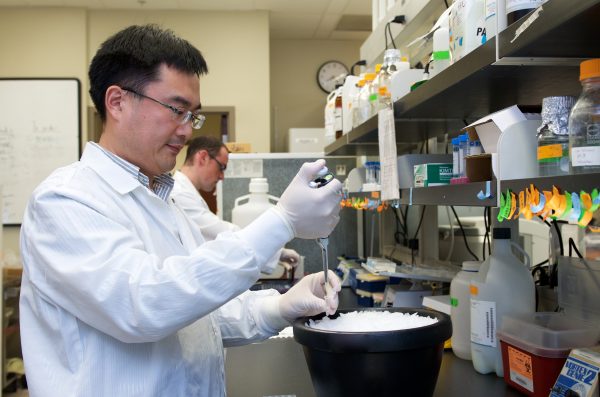Study Characterizes Key Molecular Tool in DNA Repair Enzymes

New research by UNC Charlotte scholar Shan Yan and colleagues has revealed the function of a widely shared enzyme component, the Zf-GRF domain, as a critical molecular tool necessary for manipulating DNA during repair processes.
A living organism’s DNA needs constant maintenance. Every cell is in a state of fierce siege, as plentiful reactive oxygen compounds and ions constantly assault and damage the cell’s organic molecules, especially its DNA. Oxidative damage to DNA is estimated to occur 10,000 times per day per cell.
For life to survive this molecular battlefield, molecular countermeasures have evolved, among them a suite of complex molecules that detect oxidative damage to sections of DNA molecules, targeting those areas with various repair molecules that perform a series of elaborate molecular engineering operations necessary to fix the problem. The intimate mechanics of the complex molecular assemblies dedicated to the recognition, repair and signaling of DNA damage are still not fully understood.
A specific protein structure known as the Zf-GRF domain is a mysterious component of APE2, a DNA-repair and DNA damage response enzyme, and is also common to a number of other DNA-maintaining molecules. A new research finding shows that Zf-GRF performs a critical DNA binding function in helping enzymes properly align to single-stranded DNA. The new study appears in a paper published online in The Proceedings of the National Academy of Sciences (PNAS) on December 27, 2016.
The finding is a result of two teams, one headed by Yan, a faculty member in the Department of Biological Sciences in UNC Charlotte’s College of Liberal Arts & Sciences. The second is headed by R. Scott Williams from the Genome Integrity and Structural Biology Laboratory at the National Institute of Environmental Health Sciences (NIEHS) in the National Institutes of Health.
“We study APE2, which plays an important role in repairing DNA following oxidative stress,” Yan said. “We are trying to understand the structure and function of this enzyme because it’s not very well characterized, but plays a central role in the cellular response to oxidative DNA damage.”
APE2 has different domains, he said. “One of the least understood is called Zf-GRF, which we have succeeded in characterizing,” he said. “We found that its function is to interact specifically with a single strand of DNA. If this domain does not bind to the single strand of DNA, APE2 doesn’t promote its catalytic activity and it cannot move forward in the appropriate 3’ to 5’ direction along the strand. ”
The Zf-GRF domain, Yan said, is also found in several other proteins. In all cases, it has a “claw-like” structure and other protein components surrounding a zinc molecule that are nearly identical in all cases or “highly conserved.”
“Though it’s a very small domain – about 50 amino acids – it’s highly conserved in evolution,” he said. “This enzyme domain is the same across many species, which implies that it’s important. It is also found not only in APE2, but also in many other enzymes, including important DNA metabolism enzymes such as Topoisomerase 3α and NEIL3. Our finding can be applied to future studies on those proteins.”
The ubiquity and uniformity of the Zf-GRF structure is explained, because this molecular tool plays a very useful and critical role in the control of enzymatic activity, Williams said. “The APE2 DNA processing activity is necessary for activation of “cellular checkpoints”, an alarm which is signaled when DNA damage is detected, and helps to prevent further damage from occurring, while making it possible for a cell to fix these toxic lesions,” he said. “If left in an unrepaired and un-signaled state, such oxidative DNA damage can be a major contributing factor to cancer progression, amongst other maladies.”
Authors of the paper, titled “APE2 Zf-GRF facilitates 3’-5’ resection of DNA damage following oxidative stress,” are Bret D. Wallace, Geoffrey A. Mueller, Timothy Chang, Sara N. Andres, Jessica L. Wojtaszek, Eugene F. DeRose, C. Denise Appel, Robert E. London, and R. Scott Williams from the Genome Integrity and Structural Biology Laboratory at NIEHS/NIH, and Zachary Berman, Yunfeng Lin and Shan Yan from the Department of Biological Sciences at UNC Charlotte.
The research was supported by funds from UNC Charlotte and NIGMS/NIH (grant numbers R15 GM101571 and R15 GM114713) and NIEHS/NIH (grant numbers 1Z01ES102765 and 1Z01ES050111).
Words: James Hathaway | Image: Lynn Roberson